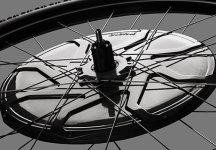LewTwo said:
Chalo said:
Hub motor wheels are inherently weaker and less reliable than conventional wheels, ....
I will grant that hub motors wheels are inherently less reliable as anything more complex is inherently less reliable.
However I would challenge the statement regarding 'inherently weaker' as they generally have larger, heavier flanges and shorter spokes.
Pray tell what you reasoning is to support that statement.
Hub motor wheels have less lateral bracing angle than normal wheels, which makes them more flexible and easier to bend or collapse. They don't have to be that way, but they are (so that the hubs can fit a bigger range of rim diameters)
Rear hub motor wheels usually have much more dish (lateral tension difference between one side and the other) than normal rear wheels. This makes them weaker and less stable, in proportion to the degree of tension imbalance.
The insertion angle of hub motor spokes into the rim, even when laced cross-one, tends to be more than optimal for the spoke, and promotes breakage at the threaded end.
Hub motor flanges are often made from steel, poorly finished and thinner than normal aluminum flanges on bicycle hubs, and drilled with holes that are too large, all of which promote breakage at the spoke elbow.
Lastly, thick spokes-- such as those which are pervasively used on hub motor wheels-- make a wheel weaker. Spokes can only work to support a rim when they are in tension; the moment they go slack, they might as well be missing (from a structural standpoint). Thick spokes lack elasticity, so they go slack much sooner and in larger numbers than thin spokes. Also because of the same lack of elasticity, they tend to overload and crack the rim at the holes. This in turn rapidly leads to wheel collapse. Again, they don't have to be that way, but they typically are.



